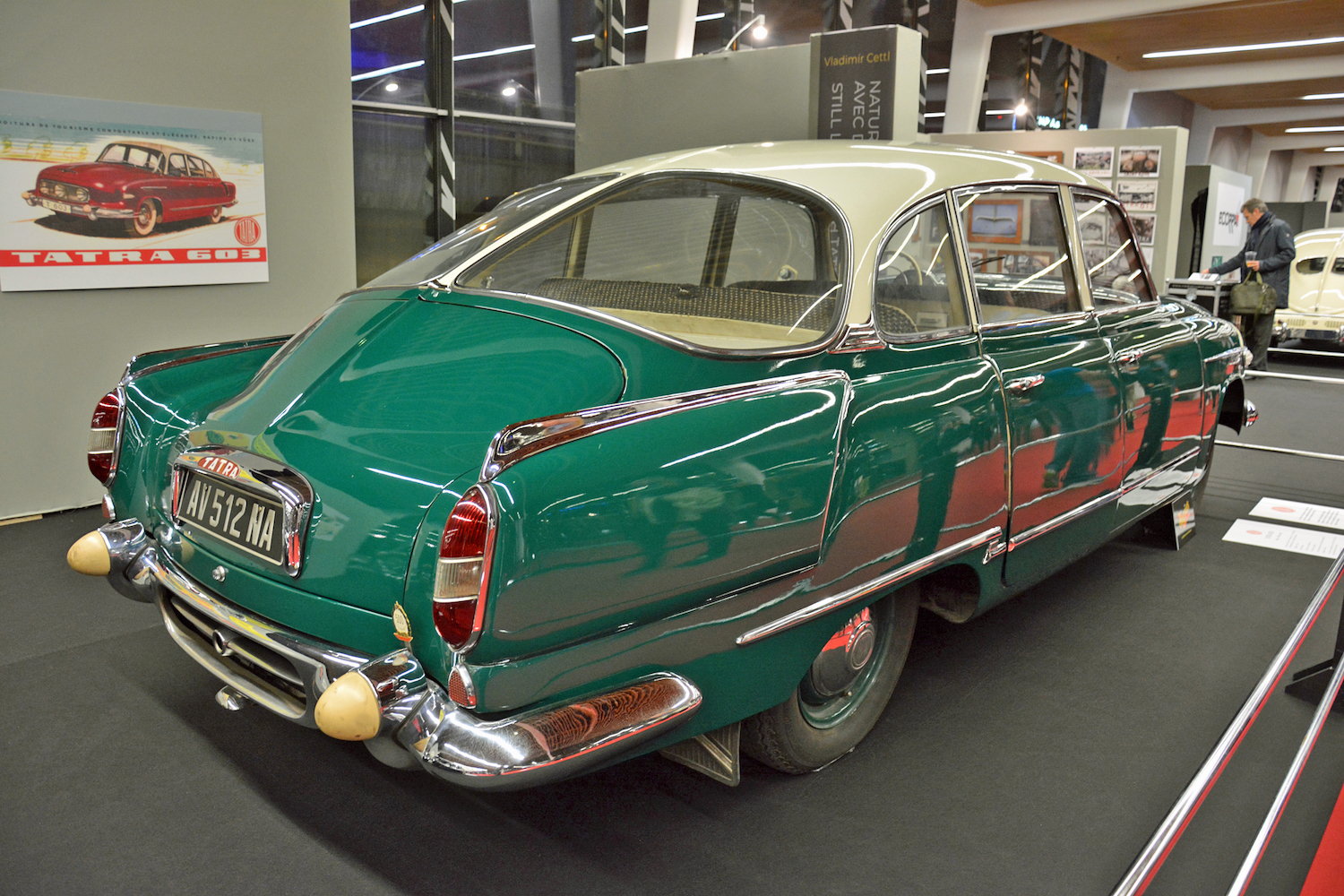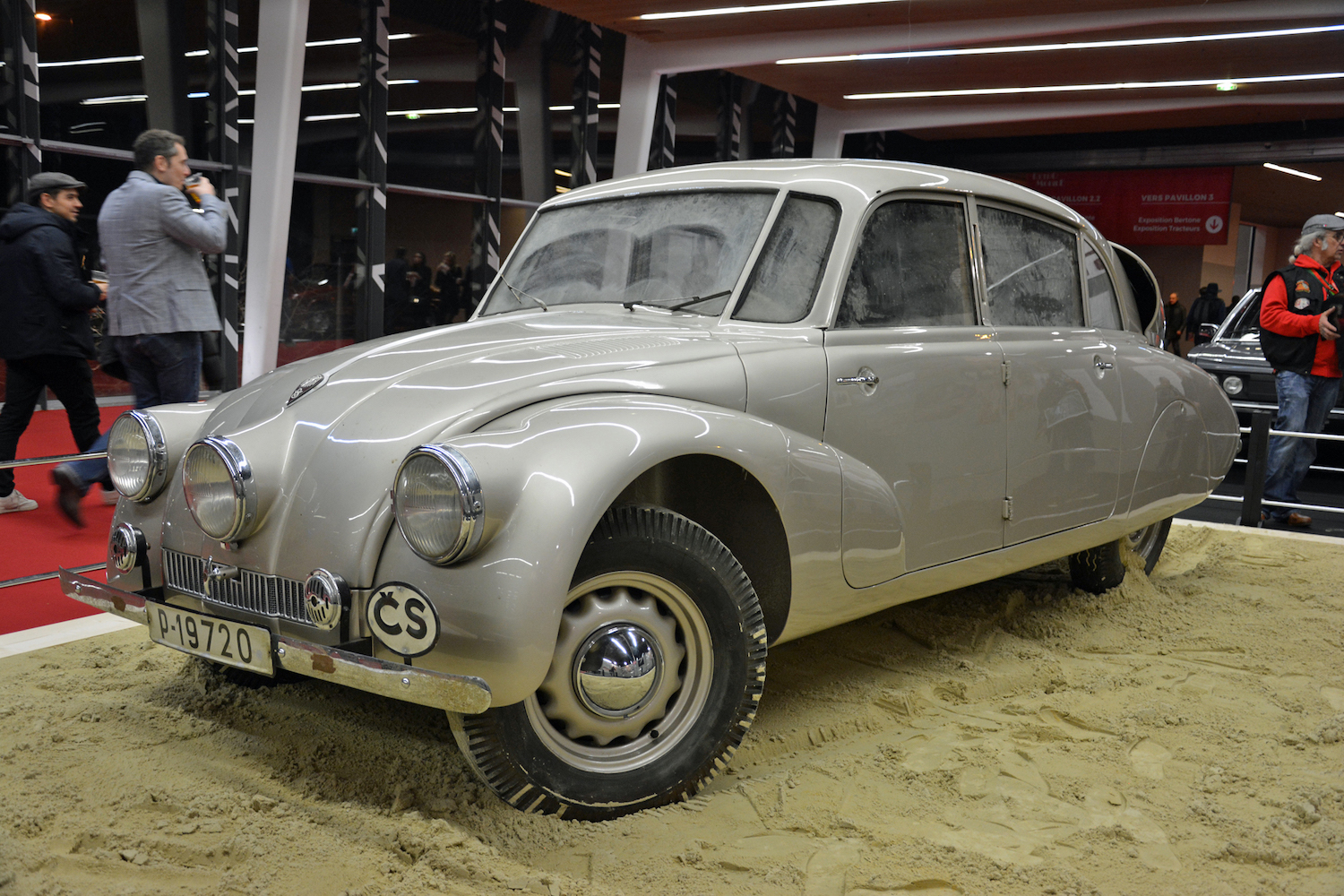Czech out this amazing Tatra lineup at Rétromobile
Tatra proves beyond doubt that an automaker can’t survive on innovation alone. The Czech company recognized the benefits of making streamlined cars before most manufacturers, but it wasn’t able to fully reap the rewards of its foresight because it quickly ended up dominated by draconian government regulations that dictated what it could and couldn’t do.
Tatra wasn’t allowed to expand into the segments it wanted a slice of, for example, and authorities eventually banned it from challenging Western rivals in the 1960 running of the high-profile Monte Carlo Rally. It was freed from its shackles too late to exploit its full potential, and in 2020 the firm is virtually unknown outside of enthusiast circles—as if it had never existed.
Collectors and museums from all over Europe brought an impressive selection of vintage Tatra models to Rétromobile 2020 to cast light on one of the more obscure car brands that operated behind the Iron Curtain. Join us for a look at how Tatra’s forward-thinking streamlined cars evolved from a one-off Volkswagen Beetle-like prototype to one of the most luxurious sedans made in eastern Europe.
Tatra V570 (1933)

An obsession with aerodynamism permeated Tatra’s design department during the early 1930s. It wanted to replace the 12, which arguably looked like a majority of the cars released during the 1920s, and engineers decided to experiment with more streamlined designs to see if they could bring one to production without having to charge a small fortune for it. V570 prototypes gradually got sleeker.
Shown here, the final prototype eschewed the sharp angles that had characterized most cars built by Tatra up to that point. Headlights sprouted from a rounded front end that flowed into an upright windshield. The roof line gradually sloped until it merged with a smooth, bumperless rear end. It was designed largely by an Austrian engineer named Hans Ledwinka, but he relied on streamlining principles established by a brilliant aircraft engineer with a keen entrepreneurial sense named Paul Jaray. It indirectly could have claimed to be born from jets just as credibly as the first Saab released in 1949.
Power for the rear-engined V570 came from an air-cooled, 854-cc flat-twin that made 18 horsepower, and its sheet metal was attached to a wooden frame installed over a steel chassis. While the prototype delivered positive results in real-world tests, it remained a one-off for reasons that are still debated.
Tatra sold the V570 to a private owner after extracting every ounce of knowledge it could get from it. The man drove it daily for 30 years before recognizing its historical significance and generously giving it back to the company, so it’s not fully original; parts were changed, and several modifications were made. I can’t imagine how hellish it must have been to drive a one-off prototype for three decades.
Although it was never mass-produced, the V570 laid the foundations every subsequent Tatra model was built on. Some historians even insist it partly influenced (or, was shamelessly copied by, depending on who you ask) engineer Ferdinand Porsche as he developed the Volkswagen Beetle.
Tatra 77 (1934–38)

Historians disagree about why Tatra stopped developing the V570. Some argue the company realized the car would have been jaw-droppingly expensive to produce, while others believe executives felt there was no need to launch a new entry-level car because the far more basic 12 still sold reasonably well. In hindsight, both sides are probably right to some extent. What’s certain is that the prototype was convincing enough to warrant scaling up its basic design onto a much bigger, more luxurious car.
Engineers working under Ledwinka’s guidance quietly designed the 77 during the 1930s, and the model made its debut at Tatra’s headquarters in 1934. At first, it’s the styling that turned heads. Its rakish silhouette was reminiscent of an airplane wing, and a massive fin dominated its rear end for added stability. Those who got their heads around it then needed to process its specifications. It used an air-cooled, 3.0-liter V-8 mounted behind the passenger compartment and tuned to develop 60 horsepower.
Keep in mind this was 1934; a 60-horse output was nothing to sneer at, especially not when it allowed the Tatra 77 to reach 90 mph while remaining relatively smooth, comfortable, and quiet. Lessons drawn from the V570 project convinced Tatra to build the 77 on a steel chassis and around a wooden frame.
An updated model named T77a arrived in 1935 with a 3.4-liter, 75-hp evolution of the V-8 and a handful of visual tweaks. Tatra made 249 examples of both 77 variants from 1934–38.
Tatra 87 (1937–50)

Named 87, the next evolution of Tatra’s finned limousine arrived in 1937 to right its predecessor’s perceived wrongs. Ledwinka privately complained the 77 didn’t handle as well as it should because it was too heavy, so he made the 87 narrower and shorter to whittle away nearly 730 pounds.
The 87 looked a lot like the 77, the two sedans shared a highly streamlined silhouette and several key styling cues, but they were fundamentally different cars. The newer model ditched its predecessor’s wood frame in favor of a more conventional steel monocoque and its updated engine—an air-cooled, 3.0-liter V-8—developed 75 hp, which was enough to unlock a 100-mph top speed.
Tatra manufactured 3023 examples of the 87 between 1937–50, though production stopped during World War II. The significant increase in sales (especially in lucrative export markets) encouraged the firm to develop a successor, even as the political climate in Czechoslovakia shifted drastically.
Tatra 600 (1948–52)

The 1940s were a period of immense change for Tatra. It was nationalized on January 1, 1946, so it had to follow the Czechoslovakian government’s orders. While this was hardly an ideal situation, the communist coup d’état of February 1948 made it exponentially worse by plunging Czechoslovakia into a decades-long spell of totalitarianism. The mid-size 600 was born in this grim, hazy context.
Also called Tatraplan, the 600 was developed to replace the 97, a smaller and more basic alternative to the 87 released in 1937 and quickly canceled. It followed in the footsteps of Tatra’s bigger models with a streamlined, fastback-like silhouette accented by a fin but it received an air-cooled, 2.0-liter flat-four out back instead of a V-8. The 52-hp output nonetheless propelled the 600 to 90 mph with ease.
The 600 holds an interesting spot in Tatra history because it could have spawned a much broader range of models. Engineers notably experimented with a diesel-powered version and they built an aluminum-bodied coupe with racing in mind. Commercial variants (including a handful of front-engined ones) were tested, too, but none of these projects made it beyond the prototype stage.
Production ended in 1952 after Tatra made 6342 units. The company exported about a third of the production run to Sweden, Canada, China, Morocco, and Belgium, among other countries, but only high-ranking government officials were allowed to buy the car in its home country.
Tatra 603 (1956–75)

The 87’s relative success proved there existed an appetite for Tatra’s unique breed of high-end sedan at home and abroad, so engineers naturally started working on a replacement. Czechoslovakia’s central planning authority begged to differ; it argued the world didn’t need another V-8-powered Tatra.
Work nonetheless continued in relative secrecy. Imagine the government’s surprise when it changed its mind after realizing its officials needed new cars and learned the model was essentially ready for production. The 603 stood out as an entirely new design with an even more elongated silhouette, a split rear window instead of a fin, and a more rounded front end. It still looked unmistakably like a Tatra.
The 603 was significantly longer and wider than the 87 but it wasn’t much heavier. It was still powered by a rear-mounted, air-cooled V-8, though its unit had a 2.5-liter displacement and it was rated at 90 horsepower. It could have easily rivaled the Citroën DS for a spot on the automotive industry’s quirkiness podium—and, oddly, the two models were made at almost exactly the same time—but authorities decided to keep nearly every example in Czechoslovakia. Exports were rare, and the few examples that made it out were usually assigned to government employees working abroad.
High-placed members of the communist party, men who ran state-owned companies, various dignitaries, and law enforcement officials drove 603s. Seeing one parked was rarely a cheerful occasion, and spotting its distinctive headlights in your rear-view mirror was downright terrifying.
Confinement didn’t hinder its success. Tatra updated the 603 twice in nearly 20 years, yet it sold 20,422 examples. As a side note, Cuban ruler Fidel Castro owned the only example equipped with factory-fitted air conditioning. He allegedly received it in exchange for shipping a Chevrolet Corvair to Czechoslovakia.
Tatra 613 (1974–95)

Tatra began developing a replacement for the 603 in the late 1960s. Early on, engineers decided to finally move away from the wing-shaped body that had characterized previous sedans and adopt a more modern look. While early prototypes were made in-house, the company surprisingly ended up outsourcing the design to Vignale, a deal made possible by Italy’s privileged ties with countries behind the Iron Curtain. The end result was a boxier, more modern-looking car that remained aerodynamic.
The new-look body hid significant technical changes. Tatra had always sought to improve the handling of its cars, but there was only so much it could achieve with a big, heavy V-8 hanging off the rear end. The 613 carried on with an air-cooled eight-cylinder, but it was mounted over the rear axle—four cylinders were behind it and the rest were in front of it, creating a configuration sometimes described as semi-mid-engined. This unusual packaging solution distributed weight more favorably while reducing the rear overhang. Early models received a carbureted engine with 165 horsepower on tap, and they could reach 120 mph, and later cars put up to 200 horses under the driver’s right foot thanks to fuel injection.
Like the 603, the 613 was primarily designed for high-ranking party officials in its home country, so it didn’t really need to be competitive; no one was cross-shopping it with a decadent Mercedes-Benz. The government nonetheless approved several mechanical and visual updates, like plastic bumpers (pictured) instead of chrome units and, somewhat ironically, Mercedes-like lights.
The Velvet Revolution in 1989 indirectly moved the 613 forward because Tatra could once again reach speed-craving motorists in western markets after democracy returned. Former Jaguar engineer Tim Bishop made several changes to the big sedan (including installing catalytic converters and developing a modern engine management system) to make it easier to sell in western European countries. Few buyers were tempted to discover this obscure gem once hidden by the Iron Curtain, but the fact that it survived at all is telling. Many other high-profile cars made in eastern Europe retired right after the USSR collapsed because they were impossible to sell. Škoda ended production of the rear-engined 135 and 136 in 1990 while the Volkswagen-powered Wartburg 1.3 and Trabant 1.1 both limped on until 1991.
About 11,000 examples of the 613 were built between 1974–95, a point by which Tatra had been privatized. There were several variants made during this long production run including open-top parade cars, extra-luxurious long-wheelbase limousines, ambulances, and airport runway testers. Vignale built a gorgeous coupe in 1969 that remained a one-off, and the 613’s drivetrain even went into a stillborn supercar that Tatra developed jointly with Czech coachbuilder Metalex in 1991.
Tatra 700 (1996–99)

Decades of serving Czechoslovakia’s communist government and a rather harsh landing after making the leap to privatization put Tatra on shaky financial footing. And yet, it chose to remain independent as its peers were either disappearing (like Trabant and Wartburg) or joining bigger automakers (like Škoda).
Working with limited resources, it decided to thoroughly update the 613 in a last-ditch effort to carve out a niche in the luxury car market. Geoff Wardle (one of the designers responsible for the second-generation Saab 900) softened the 613’s many edges and gave the front end a new look inspired by past models like the 603. Meanwhile, engineers developed a 3.5-liter evolution of the air-cooled, fuel-injected V-8 and tuned it to 198 horsepower. An astonishingly lavish interior rounded out the changes.
Named 700, the new Tatra sedan made its debut in 1995 at the Hilton Hotel in Prague. Choosing a high-profile location made sense considering its target audience, but it was also a discreet way to tell the world, “Look, we’re not communists anymore!” And yet, the brand’s unsavory association with the country’s previous regime did it no favors at home and abroad, and the 700 sold poorly. Worse yet, building it was extremely labor-intensive and Tatra allegedly lost money on every example it sold.
Tatra gave it one final shot. It developed a 4.4-liter, 231-hp evolution of the eight and gave the sedan a minor facelift in a bid to modernize it. It was too little, too late; sales never took off.
How many examples of the 700 were built depends on who you ask. I’ve seen 62, 75, and 97 listed as correct. What’s certain is that Tatra sold fewer than 100 examples. Production ended in 1999, and the company closed its car-building division to focus on heavy-duty trucks. It continues to make them in 2020; they’re reasonably popular in the Czech Republic, and some are still offered with an air-cooled V-8. Many have raced in the Dakar Rally, though the brand hasn’t won the grueling event since 2001.





























